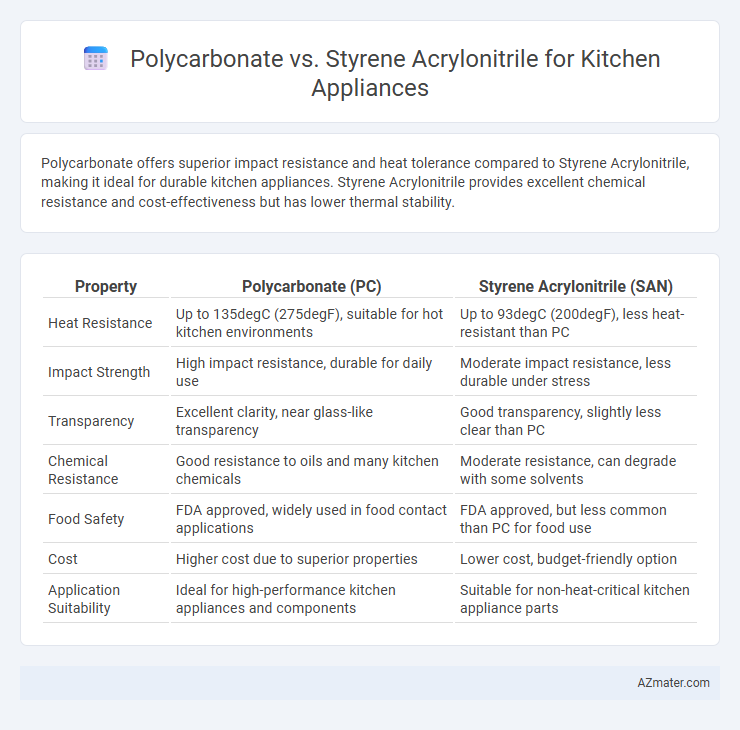Polycarbonate offers superior impact resistance and heat tolerance compared to Styrene Acrylonitrile, making it ideal for durable kitchen appliances. Styrene Acrylonitrile provides excellent chemical resistance and cost-effectiveness but has lower thermal stability.
Table of Comparison
| Property | Polycarbonate (PC) | Styrene Acrylonitrile (SAN) |
|---|---|---|
| Heat Resistance | Up to 135degC (275degF), suitable for hot kitchen environments | Up to 93degC (200degF), less heat-resistant than PC |
| Impact Strength | High impact resistance, durable for daily use | Moderate impact resistance, less durable under stress |
| Transparency | Excellent clarity, near glass-like transparency | Good transparency, slightly less clear than PC |
| Chemical Resistance | Good resistance to oils and many kitchen chemicals | Moderate resistance, can degrade with some solvents |
| Food Safety | FDA approved, widely used in food contact applications | FDA approved, but less common than PC for food use |
| Cost | Higher cost due to superior properties | Lower cost, budget-friendly option |
| Application Suitability | Ideal for high-performance kitchen appliances and components | Suitable for non-heat-critical kitchen appliance parts |
Introduction to Polycarbonate and Styrene Acrylonitrile
Polycarbonate is a durable thermoplastic known for its high impact resistance, clarity, and heat tolerance, making it ideal for kitchen appliances that require transparency and strength. Styrene Acrylonitrile (SAN) is a rigid, transparent plastic offering excellent chemical resistance and aesthetic appeal but with lower impact resistance compared to polycarbonate. Both materials are valued in kitchen appliance manufacturing for their unique properties, with polycarbonate preferred for heavy-duty applications and SAN favored for cost-effective, visually appealing components.
Chemical Structure and Composition
Polycarbonate (PC) is a durable thermoplastic polymer composed of bisphenol A units linked by carbonate groups, offering excellent impact resistance and heat stability ideal for kitchen appliances. Styrene Acrylonitrile (SAN) is a copolymer of styrene and acrylonitrile, characterized by rigidity and chemical resistance but lower heat tolerance compared to polycarbonate. The chemical structure of PC provides superior toughness and thermal endurance, making it preferable for components exposed to frequent heat and mechanical stress, while SAN is valued for its clarity and resistance to chemicals like detergents.
Mechanical Strength Comparison
Polycarbonate exhibits superior mechanical strength compared to Styrene Acrylonitrile (SAN), making it ideal for kitchen appliances subjected to frequent impact and stress. Polycarbonate's high tensile strength and excellent impact resistance ensure durability and longevity, while SAN offers moderate mechanical properties but is more prone to cracking under heavy load. Choosing Polycarbonate over SAN enhances the structural integrity of kitchen appliances, especially in high-use environments where resistance to mechanical wear is critical.
Heat Resistance and Thermal Stability
Polycarbonate exhibits superior heat resistance with a glass transition temperature around 147degC, making it suitable for kitchen appliances exposed to high temperatures. Styrene Acrylonitrile (SAN) has a lower thermal stability with a heat deflection temperature typically near 100degC, limiting its use in high-heat applications. The enhanced thermal durability of polycarbonate ensures better performance and longevity in appliances subjected to continuous heat exposure.
Optical Clarity and Aesthetic Appeal
Polycarbonate offers superior optical clarity and exceptional impact resistance, making it ideal for kitchen appliances requiring transparent or translucent components with high durability. Styrene acrylonitrile (SAN) provides good clarity and a glossy finish, enhancing aesthetic appeal, but it is more brittle and less resistant to heat compared to polycarbonate. The choice between these materials depends on balancing the need for clarity, long-term durability, and aesthetic consistency in kitchen appliance design.
Food Safety and Regulatory Compliance
Polycarbonate and Styrene Acrylonitrile (SAN) are commonly used plastics in kitchen appliances, with polycarbonate offering high impact resistance but raising concerns due to potential BPA leaching, which impacts food safety compliance. SAN provides better chemical resistance and is BPA-free, making it more favorable for regulatory standards like FDA and EFSA approvals related to food contact materials. Manufacturers prioritize SAN to meet stringent food safety regulations while ensuring durability and consumer protection in kitchen appliance applications.
Durability and Impact Resistance
Polycarbonate exhibits superior durability and impact resistance compared to Styrene Acrylonitrile (SAN), making it ideal for kitchen appliances exposed to frequent use and potential drops. Polycarbonate's high tensile strength and ability to withstand extreme temperatures without cracking ensure long-lasting performance in demanding kitchen environments. SAN, while more cost-effective and offering good clarity, lacks the robust impact resistance of polycarbonate, leading to greater susceptibility to cracking under stress.
Ease of Processing and Manufacturing
Polycarbonate offers superior ease of processing in kitchen appliance manufacturing due to its high impact resistance and thermal stability, allowing for precise molding and durability under heat. Styrene Acrylonitrile (SAN) provides a cost-effective alternative with excellent dimensional stability and ease of extrusion but lacks the toughness and thermal resistance of polycarbonate. Manufacturers prioritize polycarbonate for complex, high-stress components, while SAN is favored for simpler parts requiring good clarity and chemical resistance.
Cost-Effectiveness in Kitchen Appliance Applications
Polycarbonate offers superior impact resistance and durability, making it a cost-effective choice for high-usage kitchen appliances despite its higher initial price compared to Styrene Acrylonitrile (SAN). SAN provides a more affordable option with good chemical resistance and clarity but may require more frequent replacement due to lower toughness. Evaluating the total lifecycle cost favors polycarbonate for long-term savings in demanding kitchen environments.
Environmental Impact and Recyclability
Polycarbonate (PC) offers durability and heat resistance for kitchen appliances but poses environmental challenges due to its complex chemical structure and difficulty in recycling. Styrene Acrylonitrile (SAN) has a lower environmental footprint, as it is easier to recycle and emits fewer toxic compounds during production. Choosing SAN can enhance sustainability efforts in kitchen appliance manufacturing by reducing plastic waste and improving recyclability rates.

Infographic: Polycarbonate vs Styrene Acrylonitrile for Kitchen Appliance
 azmater.com
azmater.com